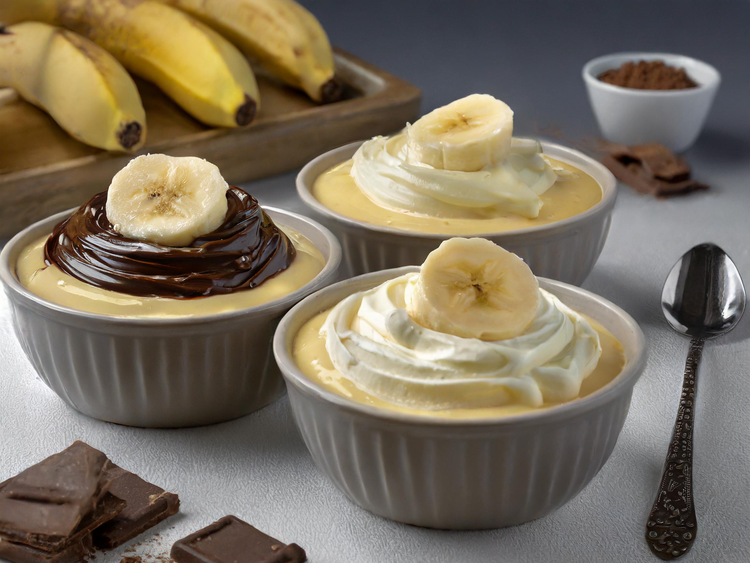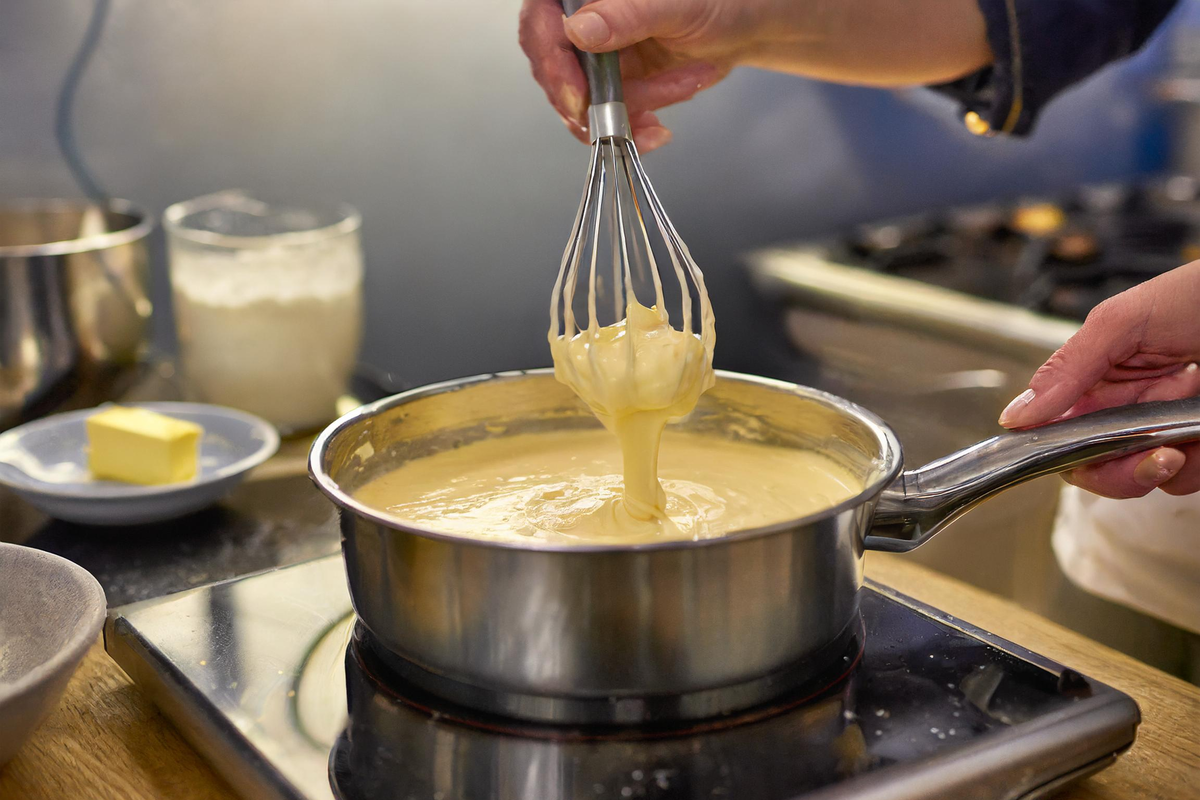A cream pie is a delicious, smooth dessert that features a rich filling, usually made from custard or pudding, and topped with a light layer of whipped cream. Understanding what cream pie filling is made of can help you create the perfect dessert for any occasion. This article will explore the common ingredients used to make the filling, different variations, and tips to get the best texture.
For another smooth, creamy dessert idea, check out this irresistible churro cheesecake recipe that combines the best of churros and cheesecake into one.
What is Cream Pie Filling?
Cream pie filling is a thick, creamy mixture typically made from ingredients like milk, cream, sugar, and eggs. The process involves cooking the filling on the stove until it thickens, giving it a smooth and velvety texture. The filling is then poured into a pre-baked pie crust and chilled until it sets.
Curious about the components of another rich dessert? Learn more about what churro cheesecake is made of, including its ingredients and preparation process.
Common Ingredients in Cream Pie Filling
1. Milk and Cream
The base of any cream pie filling is usually made from a combination of milk or heavy cream. These ingredients add richness and contribute to the overall creamy texture. The higher the fat content in the dairy, the creamier your filling will be. You can use whole milk, half-and-half, or even a mixture of both depending on your preference.
2. Egg Yolks
Egg yolks play an important role in thickening the filling. When cooked, the proteins in the yolks coagulate, turning the liquid mixture into a smooth, custard-like texture. It’s crucial to temper the egg yolks by whisking them into the hot milk gradually to prevent them from scrambling.
3. Cornstarch or Flour
To further thicken the filling, recipes often call for cornstarch or flour. Cornstarch is preferred because it gives the filling a glossy, smooth finish. However, some traditional recipes may use flour instead. Both thickeners are essential for achieving the correct consistency.
Different Types of Cream Pie Fillings

Cream pies come in many different flavors, all starting with the same basic ingredients. Here are some of the most popular versions:
Vanilla Cream Pie Filling
This classic version uses vanilla extract or vanilla bean to flavor the custard base. It’s one of the simplest and most versatile cream pie fillings.
Chocolate Cream Pie Filling
By adding melted chocolate or cocoa powder, you can transform the basic filling into a rich and indulgent chocolate cream pie. This type of filling is perfect for chocolate lovers and is often topped with chocolate shavings.
Banana Cream Pie Filling
Banana cream pie adds layers of sliced bananas between the custard and the whipped topping, creating a light and fruity contrast to the rich filling.
For a detailed breakdown of calories and ingredients in other creamy desserts, such as churro cheesecake, check out how many calories are in a churro cheesecake.
How to Make Cream Pie Filling
Ingredients:
- 3 cups whole milk or heavy cream
- 4 egg yolks, beaten
- ¾ cup sugar
- ¼ cup cornstarch
- 1 tsp vanilla extract (or flavor of choice)
- 2 tbsp butter
Instructions:
- Heat the milk: In a medium saucepan, heat the milk over medium heat until it just begins to simmer.
- Mix dry ingredients: In a separate bowl, combine sugar and cornstarch.
- Temper the eggs: Slowly whisk about ½ cup of the hot milk into the beaten egg yolks to temper them, then gradually whisk the egg mixture back into the milk.
- Thicken the filling: Stir in the sugar and cornstarch mixture, and cook until the filling thickens. This process usually takes 3-5 minutes.
- Add flavoring: Remove from heat and stir in butter and vanilla extract.
For more guidance on making whipped cream, check out how to make homemade whipped cream.
Variations of Cream Pie Fillings
You can easily adapt the basic cream pie filling to suit different tastes or dietary needs:
- Low-Fat or Vegan Options: Substitute plant-based milks like almond or coconut milk to create a vegan or lower-fat version.
- Gluten-Free Cream Pies: Swap the cornstarch for other thickening agents like tapioca starch to make your pie filling gluten-free.
- Add Flavor Enhancements: You can add lemon zest, cinnamon, or even espresso powder to the filling to enhance its flavor and add a unique twist.
How to Store and Serve Cream Pie Filling
Cream pies should be stored in the refrigerator to maintain their freshness and texture. The filling can last for up to 3 days when refrigerated, but it’s best to cover the pie to prevent the whipped topping from deflating.
While freezing is not usually recommended for cream pies due to the custard filling potentially separating, some fillings freeze better than others. If you do freeze, avoid freezing pies topped with whipped cream.
Tips for Making the Perfect Cream Pie Filling
When creating the ideal cream pie filling, several techniques can enhance both flavor and texture. First, ensure that you heat the milk or cream over medium heat to avoid scorching or curdling. If you rush this step or use too high of a temperature, you might ruin the entire batch of filling. Additionally, whisking the egg yolks thoroughly while tempering them into the hot milk helps maintain a smooth consistency without scrambling the eggs. This process allows the custard to thicken naturally without lumps forming.
After tempering the egg yolks, you should cook the filling until it thickens to your desired consistency. Stir constantly to prevent burning or sticking at the bottom of the pan. Once thickened, remove the filling from the heat and stir in butter and vanilla extract to add richness and flavor. At this point, you can adjust the flavors by incorporating ingredients like melted chocolate, coconut, or fruit puree to create customized variations of your cream pie.
While the cream pie filling cools, it’s important to prevent a skin from forming on the top of the custard. To avoid this, press a layer of plastic wrap directly onto the surface of the custard before chilling it. The plastic wrap acts as a barrier between the air and the filling, preserving its smooth texture. Once cooled, the filling will be ready to pour into a pre-baked crust and serve as the perfect base for your whipped topping.
Common Mistakes to Avoid in Cream Pie Filling
Although cream pie filling is straightforward, a few common mistakes can affect the final result. One of the biggest errors occurs when you cook the filling over too high of a heat. High temperatures can lead to curdling, causing the filling to separate or form clumps. To avoid this, always cook the mixture over medium heat and stir consistently to ensure even cooking.
Another frequent mistake involves not properly tempering the egg yolks. If you add the egg yolks directly into the hot milk mixture without slowly introducing them first, the eggs can scramble, leaving an undesirable texture in your custard. To prevent this, always temper the egg yolks by whisking a small amount of hot milk into them before gradually adding the mixture back to the rest of the filling.
Lastly, many people do not allow the custard to fully thicken before removing it from the heat. The filling needs enough time on the stove for the cornstarch to activate and the egg yolks to coagulate, which gives the filling its silky, creamy texture. Removing it too soon may leave you with a runny filling that doesn’t hold up in the pie. Be patient and cook the custard until it has visibly thickened and coats the back of a spoon.
Creative Ways to Decorate Cream Pies
Once your cream pie is assembled and chilled, the next step is decorating, which can take the presentation of your pie to the next level. A classic topping is a layer of freshly whipped cream spread across the surface of the pie. For a professional touch, you can pipe the whipped cream in decorative patterns using a piping bag. This technique adds visual appeal and allows you to create intricate designs with ease.
Beyond whipped cream, you can add flavor and texture to your pie with a variety of garnishes. For instance, sprinkle toasted coconut flakes or shaved chocolate over the top to enhance both flavor and texture. Fresh fruits, such as sliced bananas, berries, or mango, not only provide a burst of color but also complement the creaminess of the filling with their natural sweetness. Each garnish can also be tailored to match the type of pie you’ve made, such as using toasted coconut for a coconut cream pie or shaved chocolate for a chocolate cream pie.
For an even more unique touch, consider drizzling a flavored sauce, such as caramel or chocolate ganache, over the whipped topping. These sauces add a luxurious feel and rich flavors that elevate the dessert’s overall experience. By combining these decorative techniques, you can create a visually stunning and delicious cream pie that will impress both the eyes and the taste buds.
FAQs
What makes a cream pie filling thick?
The filling thickens due to the combination of cornstarch or flour, which acts as a thickener, along with the egg yolks.
Why does my cream pie filling curdle?
The filling can curdle if the eggs are added too quickly to the hot milk, causing them to scramble. Make sure to temper the eggs slowly.
Can I make cream pie filling in advance?
Yes, you can make the filling a day in advance and refrigerate it until you’re ready to assemble the pie.
How long does cream pie filling last in the fridge?
Properly stored, cream pie filling will last up to 3 days in the refrigerator.
Final Thoughts:
In conclusion, cream pie filling offers a unique combination of rich flavors and a smooth, creamy texture, making it a beloved dessert across many variations. Whether you’re preparing a classic vanilla cream pie or experimenting with chocolate or banana, the ingredients that make up the filling—milk, egg yolks, sugar, and cornstarch—come together to create a dessert that is both versatile and delicious. The custard-like filling serves as the perfect base for any number of toppings and garnishes, from whipped cream to fresh fruits or even decadent drizzles of caramel or chocolate.
By mastering the basics of cream pie filling, you open up endless possibilities for customization and creativity in your kitchen. Whether you’re crafting a pie for a special occasion or simply treating yourself to something sweet, the filling remains the star of the show, bringing both flavor and texture to each bite. Not only can you experiment with different flavors, but you can also adapt the recipe to meet dietary preferences, such as using vegan or gluten-free alternatives. This adaptability allows cream pies to remain timeless, while also providing the flexibility to keep evolving with modern tastes.
In the end, the success of any cream pie lies in its filling. By following the tips and techniques outlined here, from ensuring the right consistency to adding creative finishing touches, you will find yourself with a dessert that not only tastes indulgent but also showcases the artistry of pie-making. Cream pies prove that simplicity in ingredients can lead to something truly extraordinary when done with care and attention to detail.
